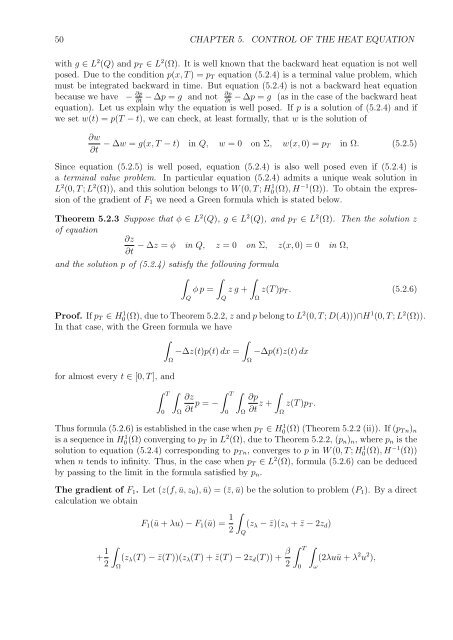Optimal Control of Partial Differential Equations
Optimal Control of Partial Differential Equations
Optimal Control of Partial Differential Equations
Create successful ePaper yourself
Turn your PDF publications into a flip-book with our unique Google optimized e-Paper software.
50 CHAPTER 5. CONTROL OF THE HEAT EQUATION<br />
with g ∈ L2 (Q) and pT ∈ L2 (Ω). It is well known that the backward heat equation is not well<br />
posed. Due to the condition p(x, T ) = pT equation (5.2.4) is a terminal value problem, which<br />
must be integrated backward in time. But equation (5.2.4) is not a backward heat equation<br />
because we have − ∂p<br />
∂p<br />
− ∆p = g and not − ∆p = g (as in the case <strong>of</strong> the backward heat<br />
∂t ∂t<br />
equation). Let us explain why the equation is well posed. If p is a solution <strong>of</strong> (5.2.4) and if<br />
we set w(t) = p(T − t), we can check, at least formally, that w is the solution <strong>of</strong><br />
∂w<br />
∂t − ∆w = g(x, T − t) in Q, w = 0 on Σ, w(x, 0) = pT in Ω. (5.2.5)<br />
Since equation (5.2.5) is well posed, equation (5.2.4) is also well posed even if (5.2.4) is<br />
a terminal value problem. In particular equation (5.2.4) admits a unique weak solution in<br />
L 2 (0, T ; L 2 (Ω)), and this solution belongs to W (0, T ; H 1 0(Ω), H −1 (Ω)). To obtain the expression<br />
<strong>of</strong> the gradient <strong>of</strong> F1 we need a Green formula which is stated below.<br />
Theorem 5.2.3 Suppose that φ ∈ L2 (Q), g ∈ L2 (Q), and pT ∈ L2 (Ω). Then the solution z<br />
<strong>of</strong> equation<br />
∂z<br />
− ∆z = φ<br />
∂t<br />
in Q, z = 0 on Σ, z(x, 0) = 0 in Ω,<br />
and the solution p <strong>of</strong> (5.2.4) satisfy the following formula<br />
<br />
φ p = z g + z(T )pT . (5.2.6)<br />
Q<br />
Q<br />
Pro<strong>of</strong>. If pT ∈ H1 0(Ω), due to Theorem 5.2.2, z and p belong to L2 (0, T ; D(A)))∩H1 (0, T ; L2 (Ω)).<br />
In that case, with the Green formula we have<br />
<br />
<br />
−∆z(t)p(t) dx = −∆p(t)z(t) dx<br />
for almost every t ∈ [0, T ], and<br />
T<br />
0<br />
Ω<br />
<br />
Ω<br />
T <br />
∂z<br />
p = −<br />
∂t 0 Ω<br />
Ω<br />
Ω<br />
<br />
∂p<br />
z + z(T )pT .<br />
∂t Ω<br />
Thus formula (5.2.6) is established in the case when pT ∈ H 1 0(Ω) (Theorem 5.2.2 (ii)). If (pT n)n<br />
is a sequence in H 1 0(Ω) converging to pT in L 2 (Ω), due to Theorem 5.2.2, (pn)n, where pn is the<br />
solution to equation (5.2.4) corresponding to pT n, converges to p in W (0, T ; H 1 0(Ω), H −1 (Ω))<br />
when n tends to infinity. Thus, in the case when pT ∈ L 2 (Ω), formula (5.2.6) can be deduced<br />
by passing to the limit in the formula satisfied by pn.<br />
The gradient <strong>of</strong> F1. Let (z(f, ū, z0), ū) = (¯z, ū) be the solution to problem (P1). By a direct<br />
calculation we obtain<br />
F1(ū + λu) − F1(ū) = 1<br />
<br />
(zλ − ¯z)(zλ + ¯z − 2zd)<br />
2 Q<br />
+ 1<br />
<br />
(zλ(T ) − ¯z(T ))(zλ(T ) + ¯z(T ) − 2zd(T )) +<br />
2 Ω<br />
β<br />
T <br />
(2λuū + λ<br />
2 0 ω<br />
2 u 2 ),

















